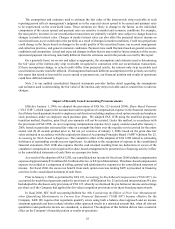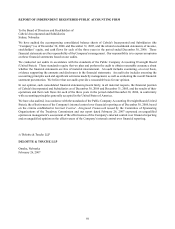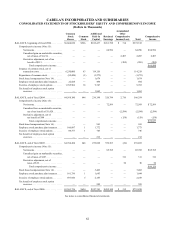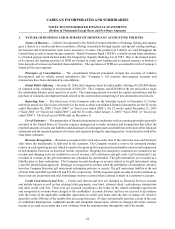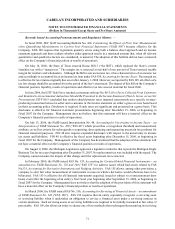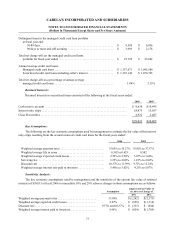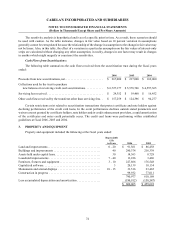Cabela's 2006 Annual Report Download - page 69
Download and view the complete annual report
Please find page 69 of the 2006 Cabela's annual report below. You can navigate through the pages in the report by either clicking on the pages listed below, or by using the keyword search tool below to find specific information within the annual report.
65
CABELA’S INCORPORATED AND SUBSIDIARIES
NOTES TO CONSOLIDATED FINANCIAL STATEMENTS
(Dollars in Thousands Except Share and Per Share Amounts)
Cost of Revenue and Selling, General and Administrative (“SG&A”) Expenses — The Company’s consolidated
cost of revenue primarily consists of merchandise acquisition costs, including freight-in costs, as well as shipping
costs. The Company’s consolidated SG&A expenses primarily consist of selling expenses, marketing expenses,
including amortization of deferred catalog costs, warehousing, returned merchandise processing costs, retail
occupancy costs, costs of operating WFB, depreciation, amortization and general and administrative expenses.
Cash and Cash Equivalents — Cash equivalents consist of commercial paper and other investments that are
readily convertible into cash and have original maturities of three months or less. Unpresented checks, net of the
bank balance in a single bank account, are classified as current liabilities. Cash and cash equivalents of WFB were
$52,830 and $80,569 at the end of fiscal 2006 and 2005, respectively. Due to regulatory restrictions the Company
is restricted from using this cash for non-banking operations, including for working capital for the direct and retail
businesses.
Short-term Investments — Short-term investments consist of auction-rate securities classified as available-for
sale. Auction-rate securities are highly-liquid investments that are reset through a “dutch auction” process that occurs
every 7 to 49 days, depending on the terms of the individual security. The underlying security can have a maturity
from 15 to 30 years. Auction-rate securities are not included as cash equivalents due to the potential uncertainties
inherent with any auction process in addition to the long-term nature of the underlying securities. The Company’s
auction-rate securities are stated at fair market value which approximates cost and therefore there were no unrealized
gains or losses related to these securities included in accumulated other comprehensive income (loss). The cost of
securities sold is based on the specific identification method. The Company had no auction-rate securities or short-
term investments on hand at the end of fiscal 2006 and 2005.
Securitization of Credit Card Loans — WFB sells a substantial portion of its credit card loans. Credit card
loans classified as held for sale are carried at the lower of cost or market. Credit card loans held for sale include
$122,824 and $68,736 of transferor’s interest in the securitized loans as of fiscal 2006 and fiscal 2005, respectively.
Net unrealized losses, if any, are recognized through a valuation allowance by charges to income. Although WFB
continues to service the underlying credit card accounts and maintains the customer relationships, these transactions
are treated as sales and the securitized loans are removed from the consolidated balance sheet. WFB retains certain
interests in the loans, including a transferor’s interest, interest-only strips, servicing rights, and in some cases cash
reserve accounts and Class B securities.
Under Statement of Financial Accounting Standards (“FAS”) No. 140, Accounting for Transfers and Servicing
of Financial Assets and Extinguishments of Liabilities, gains or losses are recognized at the time of each sale.
These gains or losses on sales depend in part on the carrying amount assigned to the credit card loans sold, which is
allocated between the assets sold and retained interest based on their relative fair values at the date of transfer. For
fiscal 2006, 2005 and 2004, WFB recognized gains on sales totaling $17,410, $17,020 and $8,864, respectively, which
are reflected as a component of securitization income in Financial Services revenue.
A servicing asset or liability is not recognized since WFB receives adequate compensation relative to current
market servicing rates.
For interest-only strips, WFB estimates related fair values based on the present value of future expected cash
flows using assumptions for credit losses, payment rates and discount rates commensurate with the risks involved.
The future expected cash flows do not include interchange income since interchange income is only earned when
and if a charge is made to a customer’s account. However, WFB has the rights to the remaining cash flows (including
interchange fees, if any) after the other costs of the trust are paid. Consequently, interchange income on securitized
loans is included within securitization income of Financial Services revenue. Components of Financial Services
revenue are presented in Note 17.


